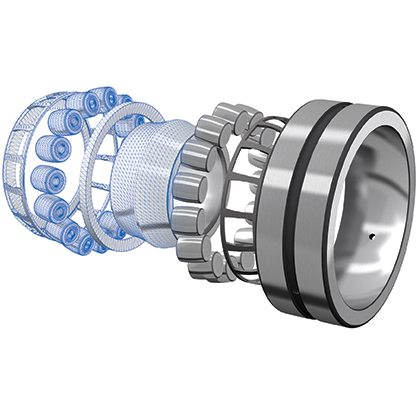Wherever there is rotating machinery—pumps included—rolling bearings perform vital functions. In general, they support shaft loads, reduce friction through rolling motion, and provide shaft location and system rigidity. For centrifugal process pumps as a specific industry example, bearings support hydraulic loads imposed on the impeller and shaft, as well as loads created by couplings and drive systems. They further keep shaft axial and radial deflections within acceptable limits for a pump’s impeller and shaft seal.
In theory, bearings possess the capability to outlast systems and equipment. But, in actuality, this is rarely the case. Many factors will influence—and threaten—the expected service life of a bearing, especially in the hostile and demanding operating conditions typically encountered in pump applications.
EVOLVING STANDARDS
For decades, ISO-standardized life calculations have helped guide educated choices about the suitability of bearing types and sizes for particular applications. Over the years, SKF has contributed substantially to the development of these standardized calculations. The resulting evolution of standards has gradually refined life calculation methods with the objective to help realize a closer match between the calculated life of a bearing and the anticipated service life in an application—with “service life” representing the actual life of a bearing in real operating conditions before it fails.
Emphasis on a bearing’s service life underscores that failures in the field often will result from “root causes” instead of sub-surface bearing fatigue. While a failed bearing becomes the victim, in most instances the failure is due to abnormal surface stresses resulting from less-than-ideal operating environments.
So the question arises: How can the actual performance and longevity of bearing arrangements in real-world operating conditions be predicted at the outset with a relatively high degree of certainty?
Considerable progress has been made with the creation of a new bearing rating life model developed by SKF to more closely align theory of bearing life and practical experience in the field. The new SKF Generalized Bearing Life Model (part of the recently launched SKF EnCompass™ Field Performance Program) builds on the strengths of the existing model developed by SKF more than twenty-five years ago and ISO-standardized worldwide.
The new rating model ultimately intends to more closely predict and optimize the longevity of a bearing in service by understanding and addressing in detail more of the factors that affect bearing life. And, already, innovations in bearing design and engineering have followed for application advantages in the field.
MODEL BEHAVIOR
The longtime bearing rating life model—calculated using a bearing’s unique basic dynamic load rating—primarily has been based on sub-surface fatigue damage accumulation and then modified with surface stress concentration models for poor lubrication and lubricant contamination. But high quality bearings, as noted, rarely fail due to sub-surface fatigue damage. Instead, failure is typically the result of surface damage caused by such factors as contamination, inadequate lubrication, or other operating conditions that lead to surface distress and wear.
The new rating life model factors these parameters into the equation and appropriately separates surface failure modes from sub-surface failure modes to gain a more precise picture of anticipated bearing performance in a given application. While the basic dynamic load rating remains a critical performance parameter, it now is not the only one in the mix for consideration.
By encompassing more parameters, the new model offers new insights. The outcome is a significantly improved road map guiding bearing engineering and selection for ideal performance and reliability in the field. Another benefit: the model’s flexible “framework” is structured to easily integrate new knowledge about tribology and material science. In effect, as bearing science evolves, so will the model and the advantages that follow.
A LOOK AHEAD
In the next part of this article, we’ll take an up-close look at other features of SKF’s EnCompass Program, including the calculation software SimPro Quick and SimPro Expert, which equip engineers with both the knowledge and the means to promote ideal bearing selection. ◆
Brian P. Dahmer is an application engineering manager at SKF USA Inc., the world’s leading bearing manufacturer. He can be reached at brian.p.dahmer@skf.com. For more information, visit www.skfusa.com.
____________________________________________
MODERN PUMPING TODAY, August 2015
Did you enjoy this article?
Subscribe to the FREE Digital Edition of Modern Pumping Today Magazine!
![]()


